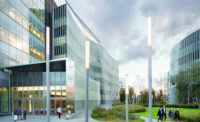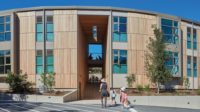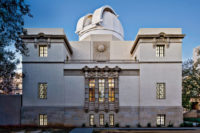Milton, Massachusetts
“True Science thrives best in glass houses, where everyone can look in,” wrote Nobel Prize–winning molecular biologist Max Perutz. Boston-based William Rawn Associates, Architects (WRA) took this sentiment to heart in the design of their Pritzker Science Center at Milton Academy, which puts visibility, in every sense of the word, front and center. The new building is evidence that the elite prep school, founded in 1798 and located in the bucolic Boston suburb of Milton, while steeped in tradition, is not stuck behind cloistered walls.
For many years Milton's science department operated out of a concrete Brutalist building. Recognizing that the outdated “bunker” might constrain the program's future, the school worked with a consultant to formally define the department's needs. The art department moved into the former science building and science moved into a temporary cluster of trailers. Meanwhile, venture capitalist and Milton alum J. B. Pritzker (of the famed Chicago family) provided a lead gift for a new building, and the project started in earnest.
The overarching mandate to make science visible was coupled with the demands to provide flexible space, foster a sense of community, and capture the energy of science. “When I was a kid,” says WRA principal William Rawn, “there was no fun to science. It was all about work. The idea of changing the paradigm was really important here—that struck a chord with me.” So the building also aimed to model the open and interconnected spaces in which professional science is practiced today, as well as to promote active learning, a hallmark of Milton.
To proclaim the new center's significance, the team selected a site along the Green, near the center of the historic, Georgian-style campus. While the architects hoped to downplay the scale of the 40,000-square-foot building by orienting its narrow end to face Centre Street, they also wanted a prominent front door, like the other street-fronting Upper School academic buildings. This feature is called out with a 35-foot-high curtain wall, animated by the activity in the public spaces and classrooms behind it. The building bends to the south, expressed as a bar, clad on the west facade with pre-patinated copper panels. The administration says the surrounding community embraced the new neighbor, acknowledging that WRA's 2003 glass-and-wood student center likely warmed the neighbors to modern design at Milton. The architects also used brick on the exterior to both break down the steel-framed building's relatively large mass as well as integrate it into the campus. If the north and west facades are the department's calling cards, the building's bowed, brick east side is its bashful cousin—a prosaic, institutional sea of red masonry and punched windows that knows its place in the backyard.
The building's form responds to its double-height, double-loaded central corridor that is flanked by classroom-labs: They combine seminar tables and group lab benches in a single room to promote hands-on learning. The plan gets a twist as the spine kinks in the middle, cleverly creating the heart of the building, which comprises student and faculty lounges. Teachers do not have private offices, so the keystone-shaped faculty lounge functions as a central gathering place, which connects, through floor-to-ceiling, butt-glazed glass walls, to the student lounge, as well as to the neighboring Inquiry Labs, where children pursue independent study. “The faculty wanted to be in the center of it all,” points out Rawn, “in the interest of fostering this scientific community.”
Visually and physically connecting the two stories largely drove the design, say the architects. By moving all mechanicals above the second level, the team lowered the ground floor's ceiling height down from the typical 14 feet to 11-foot-4, creating—along with three open stairways—an intimacy between levels. Abundant floor-to-ceiling glass brings classroom activity out to the hall and carries light into the core, as do clerestories and skylights. “Designing the interior was this progressive unveiling to the point that it became wide open,” notes associate principal Samuel Lasky. These moves are not lost on the students: “The building has a good community feel to it,” says senior Bright Osajie, over a cow heart he is dissecting. “The classes are more connected, and there is a lot of science immersed in this building—you can see science everywhere.”
Milton also wanted their building to teach sustainable practice by example. The Pritzker Center employs an impressive range of strategies, from native plantings, a green roof, 100 percent on-site infiltration of rainwater, reclaimed and locally sourced materials, daylight harvesting, and construction-waste recycling and reuse. A touch screen building dashboard in the front lounge provides real-time information on energy and resource consumption and solar electricity generation.
“I love the vitality of the building,” says department chair Michael Edgar, as students stream into the Pritzker Center for second period. “One of our aims as a department and as a school is to ignite interest and passion in our kids. Being able to see what's going on in all the classes and experience not only what you are doing, but what everyone is doing, is an excellent catalyst for getting kids excited about science.”
Location: Milton Academy, Milton, Massachusetts
Completion Date: August 2010
Gross square footage: 40,000 g.s.f.
People
Owner:
Architect:
Personnel in architect's firm who should receive special credit: (All personnel listed as AIA above are Registered Architects) Interior designer: Lab [3.2] Architecture
Engineer(s) Civil/MEP/FP: Rist-Frost-Shumway Engineering, P.C. Geotechnical: McPhail Associates, Inc.
Consultant(s) Lighting: Horton Lees Brogden Lighting Design Acoustical: Acentech, Inc. Code: R.W. Sullivan Engineering Cost Estimator: Faithful + Gould Exterior Envelope: Simpson Gumpertz & Heger General contractor: Shawmut Design and Construction
Photographer(s): |
Products
Structural system
Manufacturer of any structural components unique to this project:
Exterior cladding Metal Panels: Revere Copper Evergreen Metal/glass curtain wall: Kawneer 1600 Curtain wall – Solarban 60 1” Insulated Glazing Units Precast concrete: Northern Design Precast, Inc. (Precast Parapet Cap) Wood at soffits: Atlantic White Cedar (Supplier: Wood, Steel, and Glass, Inc.) Moisture barrier: Carlisle CCW-705 Self-Adhering AVB System Curtain wall: (See Above)
Roofing Metal: Revere Copper (Central Gathering Canopy Roof only) Other: Green roof – Liveroof Planting System
Windows
Glazing
Doors Wood doors: Lambton Doors Upswinging doors, other: (Glass & Aluminum “Garage” Doors between Classrooms) – Overhead Door
Hardware Closers: LCN Exit devices: Von Duprin Pulls: Rockwood
Interior finishes Suspension grid: Armstrong Silhouette 1/8” Screw Spline (Interior Glazing) Cabinetwork and custom woodwork: Fisher Hamilton Scientific (Classroom Lab Casework)
Paints and stains: Wall coverings: Forbo tackboards Paneling: White Ash Plywood Veneer – Wright Architectural Millwork
Solid surfacing:
Floor and wall tile: Resilient flooring in Classrooms: Marmoleum Carpet: Miliken Contract Raised flooring: The Becht Corporation (2nd floor T&G White Ash)
Special interior finishes unique to this project:
Furnishings Chairs: (Lounge) Keilhaur, HBF; (Wood Classroom) Community Tables: (Harkness Tables) McLaughlin Woods Upholstery: Maharam, Knoll Other furniture (use additional sheet if necessary): (Area Rugs) Bentley Prince Street
Lighting Task lighting: Finelite Exterior: Spring City Electrical Manufacturing Co. Dimming System or other lighting controls: Omnilite | nLight
Conveyance
Plumbing
Energy Photovoltaic system: Solarworld
Other unique products that contribute to sustainability: |





























